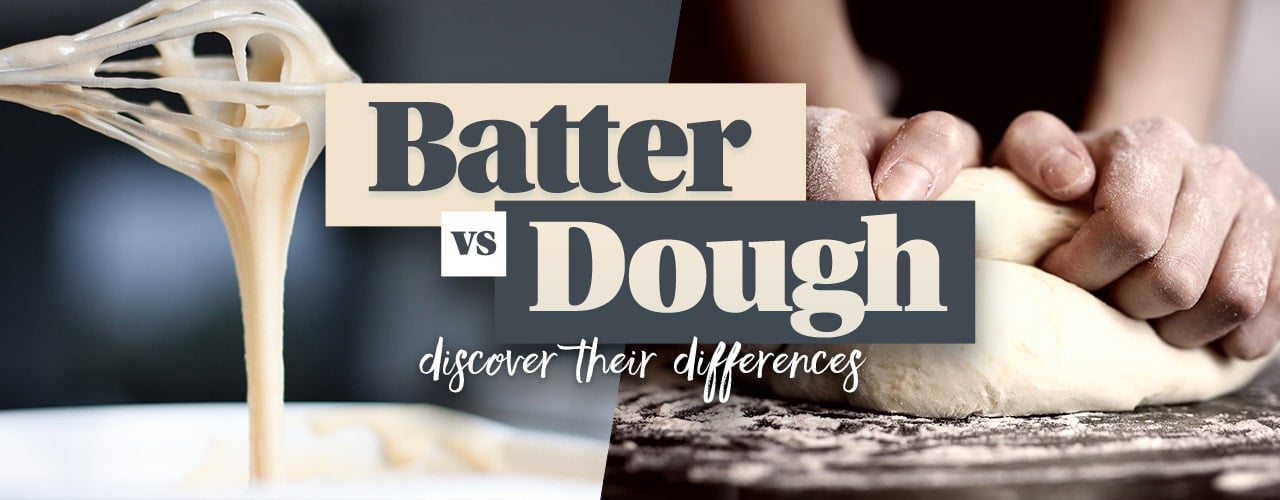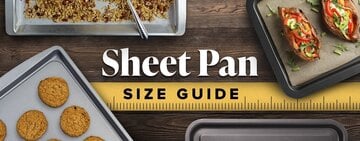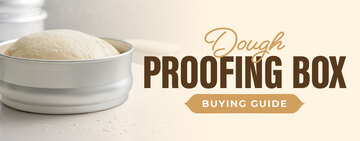Batter vs Dough
Last updated on Jun 11, 2025Corrinn McCauleyBatter and dough are to a commercial kitchen what liquor and seltzer are to a cocktail lounge—essential. Whether you operate a bakery, pizzeria, or Japanese restaurant, you use a variety of batters and doughs each day. While you may know you should whisk batter and proof dough, you may not understand exactly what dough and batter are or how they’re unique. We’ll explain the differences between batters and doughs, what dough and batter are, and break down the main dough and batter categories.
Use the links below to skip ahead learn more about batters and doughs:
- What Makes Doughs and Batters Unique?
- Batter Definition
- Dough Definition
- Leavening Explained
- Laminated Dough Definition
Difference Between Batter and Dough

The difference between batter and dough is batters are thin and contain eggs, and doughs are thick and don't have to contain eggs. Because of their different consistencies and ingredients, you will mix and prepare batters and doughs differently. We break down all the differences between batters and doughs below.
Batter vs Dough: Egg Content
- Batters must have eggs.
- Doughs don’t have to contain eggs.
Batter vs Dough: Mixing
- Doughs are dense enough for working (kneading/rolling).
- You combine batter ingredients by whisking them.
Batter vs Dough: Working With Each
- You can shape doughs into pastries, pasta, and pie crust.
- You pour or use a spoon to drop batters onto griddles and baking dishes. You can also use batters as a pre-fry coating.
What Is Batter?
Batter is a baking term that refers to a thin blend of flour, egg, and liquid that you cannot knead. Derived from the French word battre, meaning ‘to beat’, you make batters by beating/whisking their ingredients together. Culinary professionals break batters into three categories: drop batter, pour batter, and coating batter based on how they use them.
Drop Batter

Drop batters can be dropped from a spoon without running. A drop batter is normally made from a two-parts flour to one-part liquid ratio.
Drop Batter Examples:
- Muffins
- Cakes
- Drop Biscuits
- Cake Doughnuts
- Hush Puppies
- Dumplings
If you want to start a donut shop, you must create both batters and doughs to craft yeasted and cake doughnuts, respectively.
Pour Batter

Pour batters have a fluid consistency and are pourable. Unlike a drop batter, pour batters run when dropped from a spoon. Typically, pour batters have a one-to-one liquid-to-flour ratio.
Pour Batter Examples:
- Pancakes
- Waffles
- Crepes
- Funnel Cakes
Coating Batter

A coating batter is a wet food coating used to prepare items for shallow frying, deep-frying, or flat top grill quick cooking. At their most basic, coating batters are a mixture of liquid and flour/meal, but chefs often add eggs and seasonings to increase their coating batter’s flavor.
From English beer-battered cod and Southern cornmeal battered catfish to Japanese tempura vegetables and all-American onion rings, battering is a popular food preparation method in a variety of settings.
Coating Batter Examples:
- Beer Batter
- Tempura Batter
- Cornmeal Batter
- Plain Batter
What Is Dough?
At its most basic, dough is a mixture of flour/meal and a liquid. You can use any type of flour or meal to make dough. The most common liquids for dough making are milk and water. Doughs have pliable consistencies, perfect for rolling and kneading. While dough should always hold a form, you can make a soft or stiff dough by adjusting your fluid to flour/meal ratio. Discover the ratios for soft and stiff doughs below.
Stiff Dough

1 Cup of Liquid to 4 Cups of Flour/Meal
Stiff dough should feel compact but remain easy to knead and roll on a lightly floured surface.
Stiff Dough Examples:
- Scones
- Pizza Crusts
- Cookies
Soft Dough

1 Cup of Liquid to 3 Cups of Flour/Meal
While they still hold forms, soft doughs are pliable and easy to handle.
Soft Dough Examples:
- Rolls
- Biscuits
- Yeasted Doughnuts
Unleavened vs Leavened
There are many types of dough, but we can broadly categorize them as either a leavened or an unleavened dough.
Leavened Definition

The term leavened describes baked goods made with a leavening (raising) agent. There are both natural and chemical leavening agents. Fermented yeasts and sourdough starters are natural leavening agents that provide rich flavors but are time- and labor-intensive.
Baking soda and baking powder are common chemical leavening agents. We call breads leavened with chemical leavening agents “quick breads” because they require less time and labor than raising dough with a natural leavening agent.
Unleavened Definition

Unleavened describes baked goods that don’t use a leavening (raising) agent. Subsequently, unleavened doughs will not rise when baked. Doughs that don’t require a leavening agent include tortillas, pasta, crackers, and flatbreads.
Perhaps the broadest category of unleavened sweet dough is short dough. In baking, the word “short” or “shortening” is used to describe fat content, so short doughs are doughs that have more fat than flour. The desired short dough consistency is dense and soft, so they’re usually unleavened (unraised).
However, not all high-fat doughs are short doughs. Buttery but yeasted brioche doughs are not considered short doughs, and high-fat laminated doughs aren't classified as short dough either.
What Is Laminated Dough?
Laminated dough has thin alternating layers of butter and dough. Lamination is the process of rolling and folding layers of butter and dough together, developing the flour's gluten. It requires skilled hands because the alternating layers of dough and fat must be very thin.
Unlike dense short doughs, which have large quantities of butter mixed into their dough, laminated doughs are airy. Laminated dough’s alternating layers of butter and dough trap evaporating steam during the baking process, causing the layers to rise. Baked laminated doughs have hundreds of flaky layers.
While laminated doughs don’t require a leavening agent to rise, you can create a chewy texture in your laminated baked goods by adding a leavening agent to your laminated dough. Discover the top three laminated doughs below:
1. Croissant Dough
- laminated flour
- yeast
- milk
- salt
- sugar
2. Danish Pastry Dough
- laminated flour
- water
- salt
- yeast
- eggs
3. Puff Pastry Dough
- laminated flour
- water
- salt
How to Make Laminated Dough:
Follow these basic steps to make laminated dough:
- Roll your dough into the shape of a large rectangle.
- Apply a layer of butter.
- Fold your dough onto itself, encasing the butter layer inside your dough.
*You should now have a three-layered rectangle with a butter layer sandwiched between two layers of dough. - Roll out your three-layered rectangle and fold it into thirds.
- Repeat the last step twice more.
- Form your laminated dough into pastries
Non-Laminated Dough
Non-laminated doughs have fat creamed or rubbed into their flour rather than layered on top of it. You will not fold a nonlaminated dough on top of itself, and it won’t be flaky. There are both leavened and unleavened non-laminated doughs. Common non-laminated doughs include pie crust doughs, Choux pastry doughs, and short doughs. Popular uses for choux pastry dough are churros, eclairs, beignets, and cream puffs, and pastry chefs typically use short dough to make shortbread biscuits and cookies as well as tarts, quiches, and pies.
Back to TopBatters and doughs share the same heritage of flour and liquid, but they diverge in their egg content and consistencies. We categorize batters by how we use them. In contrast, we categorize doughs by their use of yeast and other leavening agents. Understanding the differences between batters and doughs will help you achieve the right consistency and apply the correct preparation method for each.



